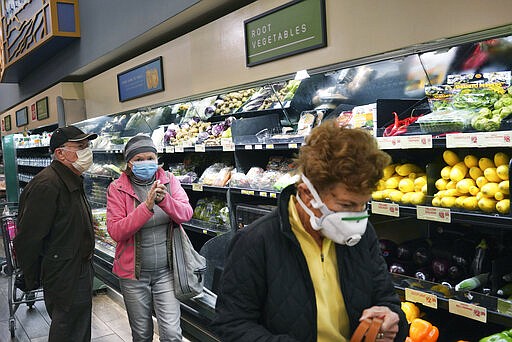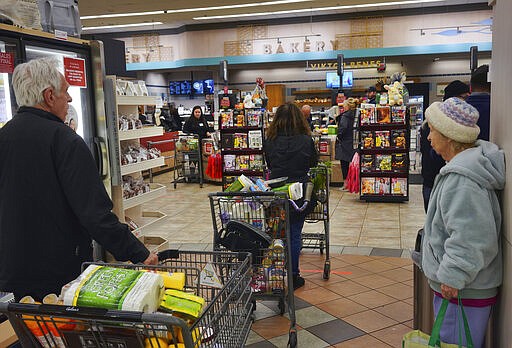California awakes to new reality: Homebound amid outbreak
LOS ANGELES (AP) — While California awoke Friday to the reality of a near lockdown to prevent the spread of coronavirus, it was business as usual for Rick Curnutt and his family, who were hunkered down in China during the outbreak and spent two weeks in self-quarantine when they returned last month.
“This is take three for us,” the Los Angeles filmmaker joked. "This has become routine by now. We’re kind of professional homebodies.”
That's not the case for nearly 40 million fellow Californians who were coming to terms with Gov. Gavin Newsom's order that they stay home indefinitely with exceptions for essential jobs, errands and some exercise.
Even after a growing number of cities and counties had placed restrictions on movement and activity, the order was a stunning development and further blow to businesses and workers reeling from the impact, and parents struggling to telecommute with children at home amid a prevalent fear of the rapidly spreading virus.
Normally congested freeways in California were truly free — of traffic — and city streets remained mostly empty in areas normally bustling with morning commuters emerging from rail stations and stopping at coffee shops and bakeries.
The governor's effort to curb the pandemic in the nation's most populous state was by far the most sweeping and was followed Friday by New York Gov. Andrew Cuomo, who banned gatherings statewide and ordered all workers in nonessential businesses to stay home.
California is one of the hardest-hit states with 1,055 confirmed cases and 19 deaths as of Friday.
Los Angeles County Health Director Barbara Ferrer urged people to stay home and only go out for essential needs. Those who have been tested and come back negative shouldn’t have a false sense of security.
“You can be negative today and positive tomorrow,” she said. “Stay home as much as possible. You are safer at home."
Still, there were plenty of signs of life from employees still working, others taking advantage of allowable activities and some pushing the limits of the new rules.
Street sweepers rolled along in Los Angeles, saws whirred at construction sites, lines snaked out grocery stores and people hit the streets for a stroll in the fresh air or to walk their dogs.
Dozens of surfers bobbed in the waters off Huntington Beach, dubbed Surf City USA, where sets of waist-high waves rolled in. But on the beach business was a bummer for Jason Murchison, whose surf lesson business had tanked during a time of year when it usually picks up during spring break.
“Everyone is terrified to come out,” he said. “Surfing is one of those sports where if you want to talk about social distancing and all that, it’s the ideal sport to do that.”
Small businesses have been crushed by the efforts to stem the pandemic. While restaurants have been able to offer takeout food, some have seen business plummet 95%, said Jot Condie, president of the California Restaurant Association.
"It's thinning out by the day," he said. “Hundreds and hundreds of employees are being laid off by the hour.”
Cities were grappling with getting a swelling homeless population off the street and authorities are looking into releasing non-violent inmates from jails to prevent the spread of COVID-19 in close confinement. The state prison system reported its first two cases among employees at different institutions, but no inmate has yet contracted it, state corrections spokeswoman Dana Simas said.
For most people, COVID-19 causes only mild or moderate symptoms, such as fever and cough. It can cause more severe illness, including pneumonia, for some people, especially older adults and those with existing health problems. The vast majority of people recover.
Newsom said infection rates are doubling every four days in some areas and projected that 56% of the state's population -- about 22 million people -- could contract the virus in the next two months if aggressive prevention isn't taken.
Residents have been told to stay 6 feet (1.8 meters) away from others, not gather in groups and wash their hands frequently.
David Mayer, a personal trainer and yoga instructor who lost his job when the San Francisco gym where he worked had to close, sprayed down a Wells Fargo ATM machine before using it. Two people who followed him, though, took no such precautions.
“I’m taking this very seriously and following the strictest of protocols because most people are not careful,” he said.
Jonathan Hidalgo was horrified to see a group yoga class at a park near his Los Angeles home where participants were helping each other stretch.
“Not the brightest of ideas,” he said.
Newsom said he expected social pressure — not policing — to help enforce his stay-at-home order. But officers in San Jose were prepared to crack down on dozens of businesses that remained open in violation of the order, Chief Eddie Garcia said.
In neighborhoods and shopping areas around the state, people were trying to adjust to a new pace of life and the severe limitations they faced.
Retiree Cathy McGinnis spent the morning with her adult daughter outside a Walgreens in the Northern California community of Plumas Lake waiting — and hoping — to buy toilet paper. She had been searching for the in-demand item for five days and had counted 40 rolls through the window.
A bigger challenge, though, was keeping the requisite distance from her daughter.
“You can’t hug anybody,” she said. “I’m a hugger.”
Alison Steffensen, a psychologist, had a makeshift office in her Sacramento front yard, with one laptop propped on the foot rest of a lawn chair and another in her lap.
The yard is usually a focal point for neighborhood gatherings, but a bounce house for kids — a potential petri dish of germs — was deflated and a library exchange box near the street was covered with blue tarps.
"Every time I wake up in the morning I think that life is kind of normal, then I realize, 'Oh, this is the strangest thing that's ever happened in my lifetime and I don't know when it's going to end,'" she said.
___
Associated Press writers Adam Beam, Don Thompson and Kathleen Ronayne in Sacramento, Stefanie Dazio and Justin Pritchard in Los Angeles, Olga Rodriguez and Juliet Williams in San Francisco, and Amy Taxin in Huntington Beach contributed to this story.
___
The Associated Press receives support for health and science coverage from the Howard Hughes Medical Institute’s Department of Science Education. The AP is solely responsible for all content.
___
Follow AP coverage of the virus outbreak at https://apnews.com/VirusOutbreak and https://apnews.com/UnderstandingtheOutbreak.




















